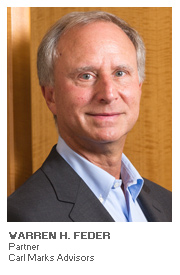
From the wisdom of Solomon and the writers of Ecclesiastes to the verse of folksinger Pete Seeger, we are reminded often of the following: To everything, there is a season. In commercial finance, we find recent examples that perhaps illustrate this belief in the Article 9 foreclosure sales conducted with Sun & Skin Care Research, LLC and Bills Khakis. ABL Advisor speaks to Carl Marks Advisors’ partner Warren Feder, who served as the exclusive financial advisor in both instances.
In what follows, Feder delves into the details concerning Sun & Skin Care’s asset sale to SolSkyn Personal Care, LLC to show that while the occurrences of Article 9 foreclosure sales may be few and far between, when certain criteria are present, the process works like a charm. Feder explains, “I happen to like Article 9 when you can use it. Admittedly, it works much better in smaller deals. Once you get into larger deals, you may run into a more complicated capital structure or situations where there is little cooperation between a borrower and its lenders or other creditors. Often times, these parties push for a bankruptcy proceeding. But this wasn’t the case with Sun & Skin Care.”
To set the stage and as the name implies, Sun & Skin Care manufactured personal products under the brand names of Ocean Potion and NO-AD, the latter being well-known to value conscious shoppers in Walmart and other drugstore chains. The company was founded by entrepreneur Gary DeAngelo, who in 2012 sold the business to Source Capital, while keeping a bit of the equity for himself. Capitala provided term debt and First Capital provided an asset-based revolver in the transaction.

Feder continues, “In 2013, the new owners brought in a new management team that came in with guns blazing and on an apparent mission to grow the top line. The top line did grow, but at the expense of profitability. The company’s debt continued to rise ... in part because of an acquisition of another brand, Bull Frog, as well as to fund operating losses for which the lenders and equity owners put in additional capital.”
By 2014, that management team was replaced and its new CEO, Stuart Straus, implemented material changes that brought Sun & Skin Care back on the path of profitability. Feder says, “The company had actually turned around and was making money again in 2015, but the challenge was the company had roughly $28 million of debt and it was way over-levered … even at its new projected level of profitability. First Capital’s loan was secured by receivables and inventory and for the most part, they were fine. But the term lender – Capitala in this case – didn’t want to stay in for the long haul and wait for a potential turnaround. They wanted to exit the credit.”
In spite of the term lender’s urge to exit, the company’s management team now led by Straus, its senior lender, Source Capital and Capitala managed to maintain a cooperative relationship throughout the process. This level of cooperation, Feder notes, is a critical aspect of successfully conducting an Article 9 sale.
Carl Marks Advisors won the mandate to serve as investment banker by virtue of the firm’s experience with consumer packaged goods and health and beauty aid companies. Feder, who’s previous experience includes tenure as an M&A lawyer, the founder of Gordon Brothers Capital and an executive of his own family’s business which manufactured among other things, suntan lotions, was able to draw on this vast experience so seek the best possible solution to address the company’s situation.
Feder notes, “We got involved in May of 2015 and one of the strategic initiatives that Stuart and his team felt very strongly about was the company should no longer be doing its own manufacturing. Needless to say, suntan lotion tends to be a seasonal business and while the company had the capacity to manufacture 30 million units per year, they were actually producing only 30% of that and there were times of the year they were more or less idle. Instead, the company wanted to focus on the branding, sales and marketing of its Bull Frog and NO-AD products and to a lesser extent, Ocean Potion. But, they wanted to get out of the manufacturing end completely.”
Now the challenge for the company was transitioning out of manufacturing at the same time Sun & Skin Care was selling the assets. In order to make the 2016 season, the buyer would need to be up and running and in a position to ship new product by November of 2015. Feder says, “It’s a bit of a juggling act to find a solution … we needed to find a way to facilitate a transaction that would be quick.”
Drawing on his prior experience, Feder realized that an Article 9 foreclosure process could be well applied in this instance. “When I ran Gordon Brothers Capital, I had done a number of the Article 9 sales as a secured lender as a way to transfer assets. As I was looking at the elements here, I realized we had a lender who was under water and we had a debtor who was cooperative and willing to agree to an orderly transfer of assets to obtain the maximum value. On top of that, we needed to get the transaction done in short order. It occurred to me that this could be an excellent situation for using an Article 9 sale.”
With that, the wheels were set in motion. Feder explains that he and his team blanketed the market by approaching strategic brand companies and contract fillers to private equity funds that either invested in consumer product companies or distressed companies. He reached out to 200 companies, sent out 80-plus confidential information memorandums and it time, received 20 bids.
Feder explains, “It was important that each of these bids came in below the $28 million that the lenders were owed. We had to conduct a very thorough market check to validate that doing an Article 9 sale at less than the face amount of the debt was a commercially reasonable transaction to do. This was critical because the Article 9 does not give the buyer quite the same protection as does an order from the Bankruptcy Court. By doing a thorough job and getting 20 offers all beneath par, the buyers were comfortable that this was indeed a commercially reasonable sale. There was no basis for arguing that we had left value on the table.”
As it turned out, SolSkyn won the bid. “We picked SolSkyn in early August and within 30 days, we did everything we needed to put us in a position to close the deal the first week of September. The key aspect here was SolSkyn was able to move key equipment the day after the deal closed to have it up and running in their facility in enough time to begin producing product for the 2016 season. Again, the timing was critical.”
Feder elaborates on a point made earlier, “You need a high degree of cooperation between the parties. Many restructuring lawyers don’t generally like to bother with an Article 9 foreclosure and prefer Section 363 sales, which are far more common. But even with expedited 363 sales, the Court has its own timetable… notices have to be sent and then there’s competitive bidding at the auction. You really don’t know who the winner will wind up being with any degree of certainty.
“With the Article 9 sale, we were able to close the deal quickly and pick the buyer ourselves in a commercially reasonable way and give SolSkyn certainty that they would win with their bid. While there are ways to truncate the process, the parties wanted to abide by the notice requirements under the statute. In this case, Capitala gave notice to the borrower and First Capital. To the extent that there were some other small lenders on assets like copier machines and such, those assets were excluded from the sale. That way, they didn’t have to give notice to those lessors and secured parties. That limited the possibility of leakage.”
Feder explains that excluding these assets and thereby limiting the number of notices required mitigated the risk of unsecured creditors binding together to throw the borrower into an involuntary bankruptcy.
Watch a short video about the use of Article 9 Foreclosure Sales from Carl Marks Advisors partner, Warren Feder.
In closing, Feder speaks briefly to the Bills Khakis transaction. As with Sun & Skin Care, there was a cooperative relationship between the equity holders and the lenders of the Pennsylvania-based men’s sportswear designer. He says, “With Bill’s Khakis, we got to the point where we had three to four bidders all below the face value of the debt. So we used Article 9 once again – this time, on behalf of Gibraltar Business Capital in order to transfer the assets in a very cost-effective and efficient way.”
Although Feder and the Carl Marks team have applied the Article 9 foreclosure process in these two recent sales within a relatively short timeframe, Feder doesn’t expect this portends an emerging trend. “I admit that I’ve had the Article 9 bug of late, but I don’t expect to see an onslaught of these in the future. That being said, lenders may want to consider this process when they encounter situations that are similar to Sun & Skin Care and Bill’s Khakis.”